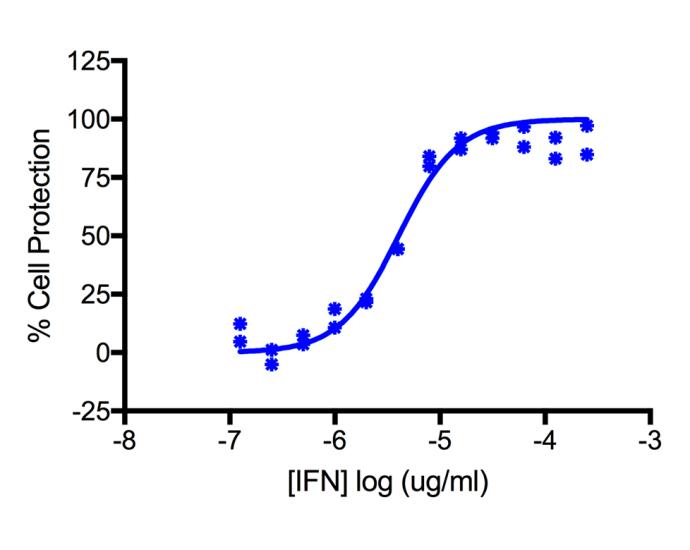Human IFN-Alpha 2a (Alpha A) Protein, Carrier-Free
Catalog Number: 11101
- E.coli expressed Human IFN-Alpha 2a (Alpha A) recombinant protein
- Provided in carrier-free formulation suitable for in vivo studies in humanized animal models
- High purity with less than 1 EU/ug endotoxin
$260.00
Product Info
Recombinant Human IFN-Alpha A (alpha 2a) carrier-free, obtained from human leukocyte mRNA expressed in E.coli.
IFN-Alpha 2a is one of the many interferon alpha subtypes belonging to the Type I leukocyte IFN family. The Type I IFN family has antiviral, anti-proliferative and natural killer cell activities.
IFN-Alpha 2a and b are the most widely used therapeutic IFN-Alphas.
Specifications
| Formulation | Supplied frozen in phosphate-buffered saline (PBS) |
|---|---|
| Molecular Weight | 19.2 kDa |
| Source | Human leukocyte interferon CDNA expressed in E.coli |
| Purity | > 95% by SDS_PAGE stained by Coomassie Blue |
| Bioactivity | Measured using a cytopathic inhibition assay on Bovine Kidney Cells (MDBK) with Vesicular Stomatis Virus (VSV); human lung carcinoma cell line A549 with encephalomyocarditis virus (EMCV) |
| Storage | For retention of full activity store at -70 ºC or below and avoid repeated freeze-thaw cycles |
| Synonyms | Interferon alpha A, IFN alpha A, IFNaA, IFN alpha 2a, IFN alpha A, IFN-a, interferon alpha, IFN-a2a, interferon alpha 2a, Leukocyte interferon, Leukocyte IFN, alpha interferon, interferon alfa, IFN alfa, interferon alpha 2a, IFN alpha 2a, interferon a, Type I interferon alpha, Type I IFN alpha |
| Accession Number | V00549 |
Citations
12 Citations
- Yu, Y. et al., (2023), "An RNA_based system to study hepatitis B virus replication and evaluate antivirals", Sci Adv., 9(15):eadg6265, PMID: 37043562, DOI: 10.1126/sciadv.adg6265 (link)
- Le-Trilling, Vu Thuy Khanh, et al. (2020). The Human Cytomegalovirus pUL145 Isoforms Act as Viral DDB1-Cullin-Associated Factors to Instruct Host Protein Degradation to Impede Innate Immunity. Cell Reports, 19 pgs. PMID: 32075763. (link)
- Szabo, Peter, et al. (2019). Single-cell transcriptomics of human T cells reveals tissue and activation signatures in health and disease. Nature Communications, 16 pgs. PMID: 31624246. (link)
- Landegren, Nils, et al. (2019). Comment on 'AIRE-deficient patients harbor unique high-affinity disease-ameliorating autoantibodies'. eLife Sciences, 13 pgs. PMID: 31244471. <(link)
- Braun, Elisabeth, et al. (2019). Guanylate-Binding Proteins 2 and 5 Exert Broad Antiviral Activity by Inhibiting Furin-Mediated Processing of Viral Envelope Proteins. CellPress, 24 pgs. PMID: 31091448. (link)
- Anderson, Danielle, et al. (2019). Comparative Loss-of-Function Screens Reveal ABCE1 as an Essential Cellular Host Factor for Efficient Translation of Paramyxoviridae and Pneumoviridae. mBio, 22 pgs. PMID: 31088929. (link)
- Antiochos, Brendan, et al. (2018). IFI16 Filament Formation in Salivary Epithelial Cells Shapes the Anti-IFI16 Immune Response in Sjorgen's Syndrome. JCI Insight, 16 pgs. PMID: 30232276. <(link)
- Szaniawski, Matthew, et al. (2018). SAMHD1 Phosphorylation Coordinates the Anti-HIV-1 Response by Diverse Interferons and Tyrosine Kinase Inhibition. mBio, 14 pgs. PMID: 29764952. (link)
- Mueller, Janis, et al. (2017). Development of a High-Throughput Colorimetric Zika Virus Infection Assay. Medical Microbiology and Immunology, 11 pgs. PMID: 28176006. (link)
- Wescott, Marlena, et al. (2015). Interferon Beta and Interferon Alpha 2a Differentially Protect Head and Neck Cancer Cells from Vesicular Stomatitis Virus-Induced Oncolysis. JVI, 11 pgs. PMID: 25995245. (link)
- Sun, Eileen, et al. (2012). Dissecting the Role of COPI Complexes in Influenza Virus Infection. JVI, 13 pgs. PMID: 23255804. (link)
- Murray, E, et al. (2011). Knockdown of USP18 Increases Alpha 2a Interferon Signaling and Induction of Interferon-Stimulating Genes but Does Not Increase Antiviral Activity in Huh7 Cells. Antimicrobial Agents and Chemotherapy, 9 pgs. PMID: 21709085. (link)

